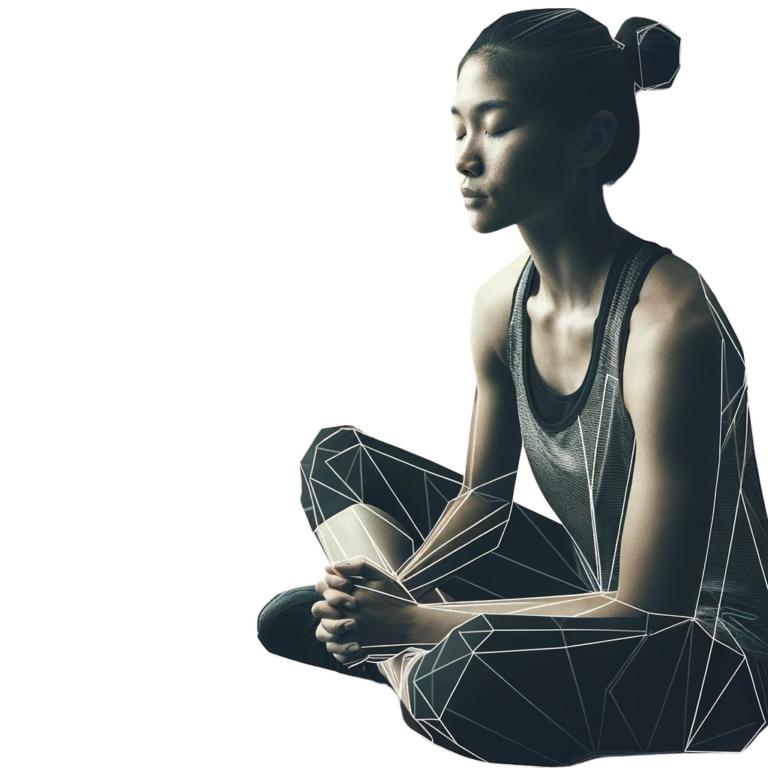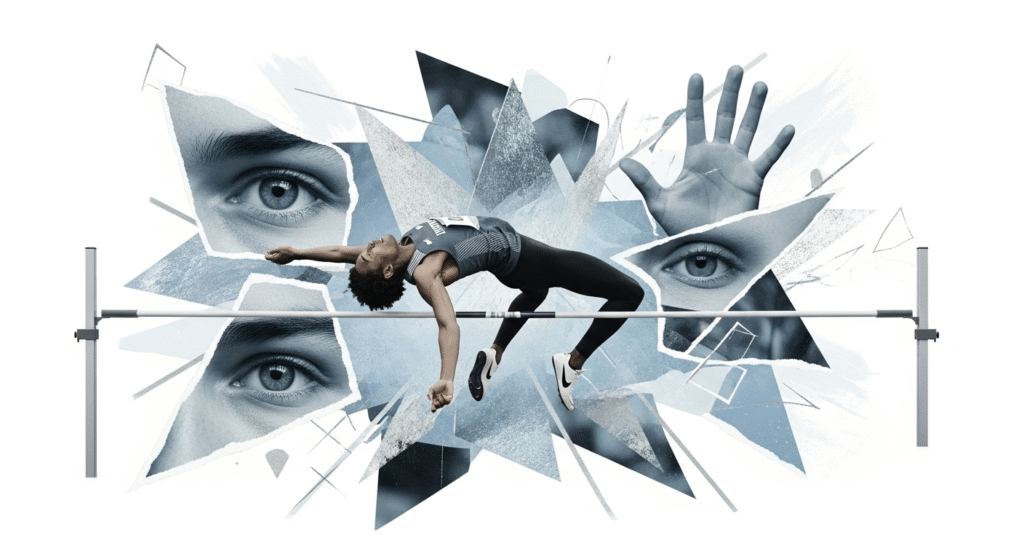
High Jump Psychology: High jump competitions demand not only physical prowess but also significant mental fortitude. The moment before takeoff—when an athlete faces the bar set at a challenging height—can trigger waves of anxiety that compromise even the most technically sound jumper. While coaches often focus on perfecting approach speed, takeoff mechanics, and the Fosbury Flop technique, the psychological dimension of high jumping frequently remains under addressed.
Yet mental preparation can be the deciding factor between clearing the bar and knocking it down. Elite high jumpers understand that competition success hinges on their ability to manage pressure, maintain focus, and execute with confidence when it matters most. The difference between a personal best and a disappointing performance often resides not in physical capability but in psychological readiness.
This comprehensive guide explores proven mental preparation techniques specifically designed for high jump athletes to reduce anxiety, enhance focus, and build unwavering confidence. From visualization exercises that program your mind for successful clearances to mindfulness practices that keep you centered during competition, these strategies offer a psychological toolkit for high jumpers at all levels. By mastering these mental approaches alongside physical training, athletes can optimize their performance and achieve their highest potential during competitions.
High Jump Psychology: Visualization Techniques for Peak Performance
Visualization, sometimes called mental imagery or mental rehearsal, is a powerful technique used by elite high jump athletes to program success into their minds before they even approach the bar. This practice involves creating detailed mental simulations of perfect jumps, essentially giving your brain a preview of what you want your body to execute.
Neuroscience research reveals that visualization activates many of the same neural pathways used during physical performance. When you vividly imagine yourself clearing a height, your brain forms connections that support this outcome when you actually attempt the jump. For high jumpers, this mental practice can significantly reduce anxiety and improve technical execution.
Effective visualization for high jump competition requires engaging all your senses. Picture yourself arriving at the venue, feel the texture of the track beneath your spikes, hear the ambient sounds of the competition, and sense the anticipation in your muscles. Then mentally rehearse your entire jump sequence—from your approach run to your takeoff, flight phase, and successful bar clearance. The more detailed and emotionally connected your visualization, the more powerful its impact on performance.
World champion high jumpers often incorporate visualization into their daily training regimen, spending 10-15 minutes mentally rehearsing successful jumps at competition heights. This consistent mental practice builds what sports psychologists call ‘performance blueprints’—neural patterns that your body naturally follows during actual competition. By repeatedly visualizing successful clearances, you’re training your mind to expect success rather than fear failure.
Many coaches recommend practicing visualization under various conditions that mimic competition pressure. Visualize successfully clearing heights when you’re tired, when there’s a noisy crowd, or when you’re trailing in the standings. By mentally rehearsing success through various challenging scenarios, you prepare your mind to stay calm and focused regardless of external circumstances.
- Create detailed mental images of each phase of the jump, from your approach run to bar clearance, engaging all senses to make the experience more vivid and impactful.
- Visualize overcoming obstacles and executing perfect form under pressure, including successfully clearing personal best heights and maintaining composure during high-stakes situations.
Mindfulness and Present Moment Focus
High jump competitions can overwhelm athletes with distractions—from the pressure of expectations to thoughts about previous failures or concerns about competitors’ performances. Mindfulness training offers high jumpers a powerful antidote to these mental disruptions by anchoring attention firmly in the present moment.
Mindfulness, at its core, involves maintaining awareness of the present without judgment. For high jumpers, this means developing the capacity to focus solely on the current jump rather than dwelling on past attempts or worrying about future ones. This present-moment awareness is particularly crucial during competitions, where a wandering mind can compromise technical execution and confidence.
Breathing exercises serve as fundamental mindfulness tools for high jumpers. Deep, controlled breathing activates the parasympathetic nervous system, counteracting the fight-or-flight response triggered by competition anxiety. Before approaching the bar, many elite jumpers practice a simple 4-7-8 breathing technique—inhaling for four counts, holding for seven, and exhaling for eight—to center their focus and calm their nervous system.
Grounding techniques complement breathing exercises by helping athletes reconnect with the present when anxiety threatens to derail performance. The ‘5-4-3-2-1’ method is particularly effective for high jumpers experiencing pre-competition jitters. This involves acknowledging five things you can see (perhaps the bar, the landing mat, your coach, etc.), four things you can touch (your spikes, the track surface, etc.), three things you can hear, two things you can smell, and one thing you can taste. This sensory inventory rapidly brings your attention back to the present moment.
Many successful high jumpers incorporate brief mindfulness practices into their competition routines. Taking 30-60 seconds before each jump to close your eyes, focus on your breathing, and mentally scan your body can significantly reduce anxiety and sharpen focus. This micro-meditation clears mental clutter and creates space for optimal performance.
Consistent mindfulness practice during training builds the mental muscle needed for competition focus. By regularly bringing attention to your body sensations, breathing patterns, and emotional state during practice jumps, you develop greater awareness of how these factors influence performance. This heightened self-awareness becomes invaluable during competitions, allowing you to quickly identify and address tension or anxiety before it affects your jump.
- Incorporate breathing exercises to calm the mind before attempts, using techniques like 4-7-8 breathing or rhythmic breathing patterns to activate the parasympathetic nervous system and reduce pre-jump anxiety.
- Use grounding techniques to shift focus away from distractions and anxiety, implementing sensory awareness exercises to anchor yourself in the present moment and maintain optimal focus during competition.

Positive Self-Talk and Confidence Building
The internal dialogue running through a high jumper’s mind can significantly impact performance outcomes. Negative self-talk—those critical, doubtful thoughts that question your ability to clear the bar—triggers physiological stress responses that interfere with coordination and power. Conversely, positive self-talk reinforces confidence, reduces anxiety, and promotes optimal activation for successful jumps.
Many high jumpers unconsciously undermine their performance through harmful internal messages. Thoughts like ‘This height looks impossible’ or ‘I’m going to hit the bar again’ program the mind for failure rather than success. Recognizing these counterproductive thought patterns is the first step toward transforming them into performance-enhancing affirmations.
Developing personalized, meaningful affirmations creates a powerful psychological foundation for high jump success. These positive statements should be specific, present-tense, and emotionally resonant. Rather than generic phrases like ‘I can do this,’ effective affirmations for high jumpers might include: ‘My approach is powerful and precise,’ ‘I convert horizontal speed to vertical elevation perfectly,’ or ‘I clear this height with room to spare.’
The timing of positive self-talk matters significantly for high jumpers. Research indicates that performance affirmations are most effective when used during three key periods: during training to establish positive neural patterns, during pre-competition preparation to build confidence, and during competition itself to maintain focus and overcome setbacks. Many elite jumpers develop specific affirmations for different phases of competition—approach run, takeoff, and bar clearance.
Replacing negative thoughts requires consistent practice and awareness. When negative self-talk emerges—perhaps after missing a height or during a challenging competition—successful jumpers employ thought-stopping techniques followed by immediate replacement with constructive statements. This might involve mentally saying ‘Stop!’ when doubts arise, then consciously shifting to statements like ‘I adjust quickly and clear this height next attempt.’
Confidence-building extends beyond self-talk to encompass evidence collection. Many sports psychologists recommend keeping a ‘success journal’ where high jumpers record their achievements, breakthrough moments, and effective techniques. Reviewing this evidence of capability before competitions serves as a powerful antidote to self-doubt, reminding athletes of their proven abilities under pressure.
- Develop personalized affirmations that reinforce self-belief and capability, creating specific statements that address technical aspects of your jump as well as mental strength and competitive confidence.
- Replace negative thoughts with constructive and empowering statements, implementing thought-stopping techniques and immediately substituting performance-enhancing messages to maintain a winning mindset.

Mental preparation represents the often-overlooked dimension that separates good high jumpers from great ones. While physical training develops the necessary strength, speed, and technique to clear impressive heights, psychological readiness determines whether these capabilities translate into consistent competitive success.
The mental strategies outlined in this article—visualization techniques, mindfulness practices, positive self-talk, and structured goal setting—form a comprehensive toolkit for high jump athletes seeking to optimize their performance under pressure. By implementing these approaches systematically, jumpers can effectively manage anxiety, enhance focus, and build the confidence needed to reach their full potential.
Perhaps most importantly, these psychological skills transfer beyond the high jump pit to enhance overall well-being and resilience. The mental discipline cultivated through visualization practices, the emotional regulation developed through mindfulness, and the positive thought patterns established through constructive self-talk create a foundation for success in all areas of life.
As you integrate these mental preparation techniques into your training regimen, remember that psychological skills develop through consistent practice just like physical abilities. Start with small implementations, notice the impacts on your performance and mindset, and gradually expand your mental training program.
By embracing these psychological strategies alongside physical training, you cultivate not just a stronger body but also a more resilient mind—one capable of expressing your full athletic potential when it matters most. This holistic approach to high jump excellence empowers you to clear not just physical bars but also the mental barriers that so often limit athletic achievement

